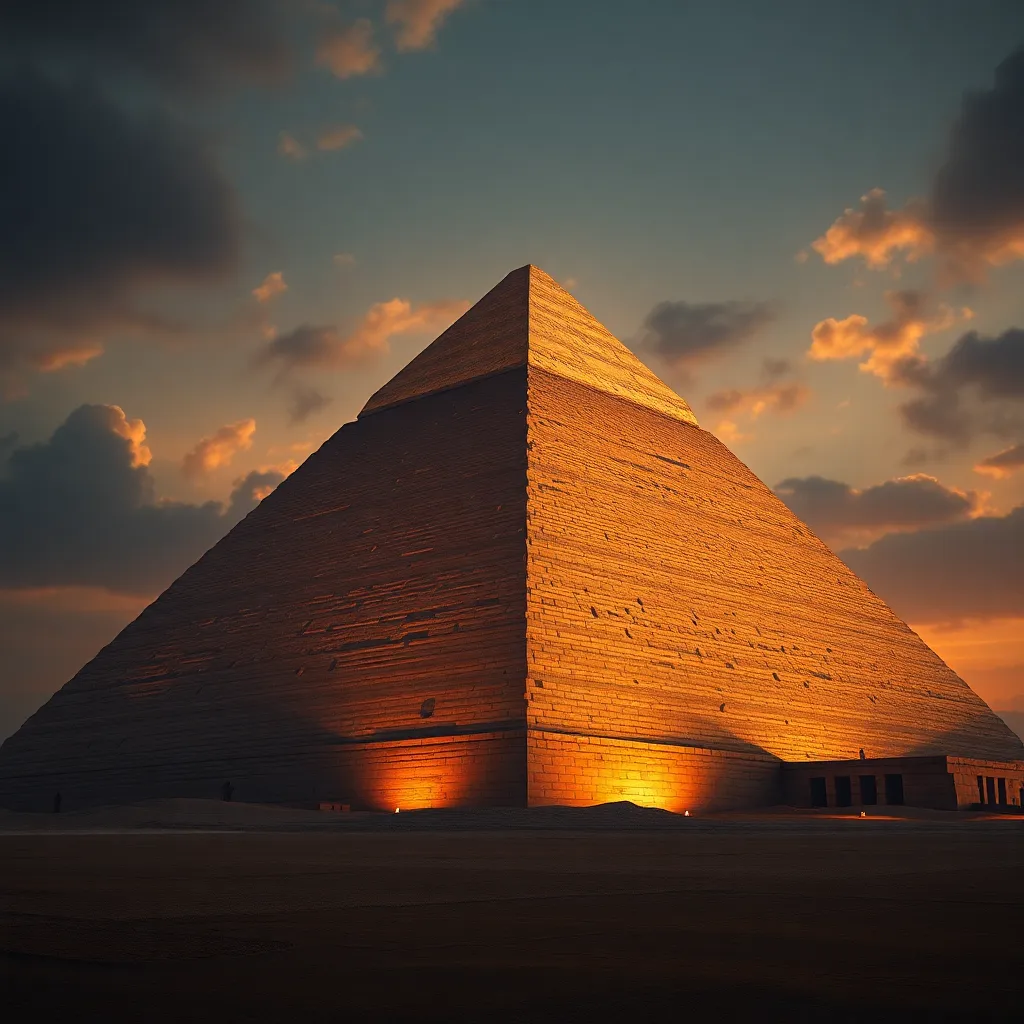The Great Pyramid: A Testament to Ancient Egyptian Beliefs
I. Introduction
The Great Pyramid of Giza, one of the most recognizable structures in the world, stands as a monumental testament to the beliefs and values of ancient Egyptian civilization. Built during the Old Kingdom period, this architectural marvel not only symbolizes the impressive engineering capabilities of the Egyptians but also reflects their profound religious and cultural ideologies.
Understanding the Great Pyramid within its cultural and religious context is essential for appreciating its significance. It served as a royal tomb, a place of worship, and a connection between the earth and the divine. This article delves into the historical background, architectural features, symbolism, and the lasting legacy of the Great Pyramid.
II. Historical Context of Ancient Egypt
A. Overview of the Old Kingdom period
The Great Pyramid was constructed during the Fourth Dynasty of the Old Kingdom, around 2580 – 2560 BCE. This period is often referred to as the “Age of the Pyramids,” characterized by remarkable advancements in art, architecture, and centralized state power.
B. The role of pharaohs in society and religion
Pharaohs were viewed as divine rulers, intermediaries between the gods and the people. Their primary responsibilities included maintaining ma’at, the ancient Egyptian concept of truth, balance, and cosmic order. The construction of monumental structures, such as the Great Pyramid, was believed to ensure the pharaoh’s successful transition to the afterlife and his continued influence in the realm of the living.
III. Architectural Marvel
A. Construction techniques and materials used
The construction of the Great Pyramid involved an estimated 2.3 million blocks of stone, primarily limestone and granite. Each block weighed between 2.5 and 15 tons. The techniques used for quarrying, transporting, and assembling these massive stones remain a subject of fascination and research among historians and archaeologists.
B. The pyramid’s dimensions and layout
The Great Pyramid originally stood at 146.6 meters (481 feet) tall, making it the tallest man-made structure in the world for over 3,800 years. Its base covers an area of 13 acres, with each side measuring approximately 230.4 meters (756 feet). The precise alignment of the pyramid to the cardinal points further demonstrates the Egyptians’ advanced understanding of geometry and astronomy.
IV. Symbolism of the Great Pyramid
A. Representation of the afterlife and resurrection
The Great Pyramid was designed as a gateway to the afterlife. Its unique shape, resembling a rising sun, symbolized the pharaoh’s resurrection and ascension to the heavens. The internal chambers, including the King’s Chamber and the Queen’s Chamber, were believed to facilitate the soul’s journey after death.
B. Connection to the divine and the role of the pharaoh
The Great Pyramid also embodied the connection between the pharaoh and the gods. It served as a physical manifestation of the divine order, reinforcing the pharaoh’s status as a god on earth. This connection was crucial for maintaining the favor of the gods and ensuring the prosperity of the nation.
V. The Pyramid Complex and Its Surroundings
A. The Sphinx and surrounding temples
The Great Pyramid is part of a larger complex that includes the Great Sphinx of Giza and several mortuary temples. The Sphinx, with its lion’s body and human head, is believed to represent the pharaoh and serves as a guardian to the pyramid complex. The temples associated with the pyramids were sites for rituals and offerings to honor the deceased pharaoh.
B. The significance of the Giza plateau
The Giza plateau is not only home to the Great Pyramid but also to two other major pyramids—the Pyramid of Khafre and the Pyramid of Menkaure. This area was considered sacred, symbolizing the connection between the living world and the afterlife, making it an essential site for both religious and cultural activities.
VI. Religious Practices and Burial Traditions
A. Mummification and its importance in the afterlife
Mummification was a crucial aspect of ancient Egyptian burial practices, aimed at preserving the body for the afterlife. The Great Pyramid served as a final resting place for the pharaoh, ensuring his physical form remained intact for eternity. This practice reflected the Egyptians’ belief in the soul’s journey after death and the need for the body to be preserved for that journey.
B. Offerings and rituals associated with the pyramid
Rituals and offerings were performed at the pyramid to honor the deceased pharaoh and facilitate his passage into the afterlife. These included:
- Food and drink offerings placed in the mortuary temples.
- Daily rituals conducted by priests to sustain the pharaoh’s spirit.
- Burial goods buried with the pharaoh, including jewelry, tools, and food.
VII. Legacy and Influence on Future Generations
A. Impact on subsequent Egyptian architecture
The Great Pyramid set a standard for future pyramid constructions and influenced subsequent architectural designs. Its grandeur and engineering techniques were emulated in later periods, leading to the development of more elaborate pyramid complexes and monumental structures throughout Egypt.
B. The Great Pyramid in modern culture and tourism
Today, the Great Pyramid is one of the Seven Wonders of the Ancient World, attracting millions of tourists each year. It continues to capture the imagination of people worldwide, symbolizing the ingenuity and mystery of ancient Egypt. Its representation in popular culture, literature, and media further solidifies its status as a cultural icon.
VIII. Conclusion
The Great Pyramid of Giza stands as a remarkable cultural artifact, reflecting the beliefs, values, and advanced capabilities of ancient Egyptian civilization. Its significance transcends time, offering insights into the religious and architectural practices of a society that revered the afterlife and the divine. As we continue to explore its mysteries, the Great Pyramid remains a vital link to understanding the enduring legacy of ancient beliefs.




